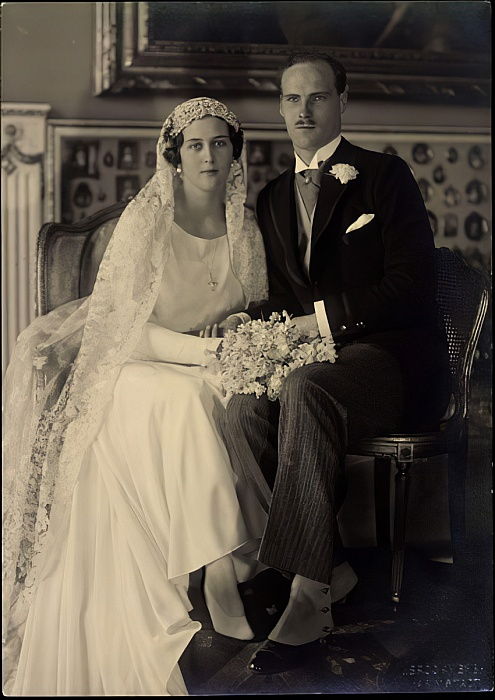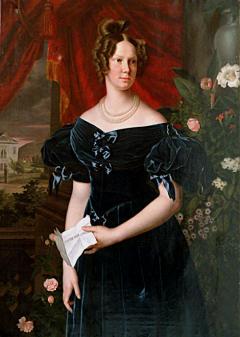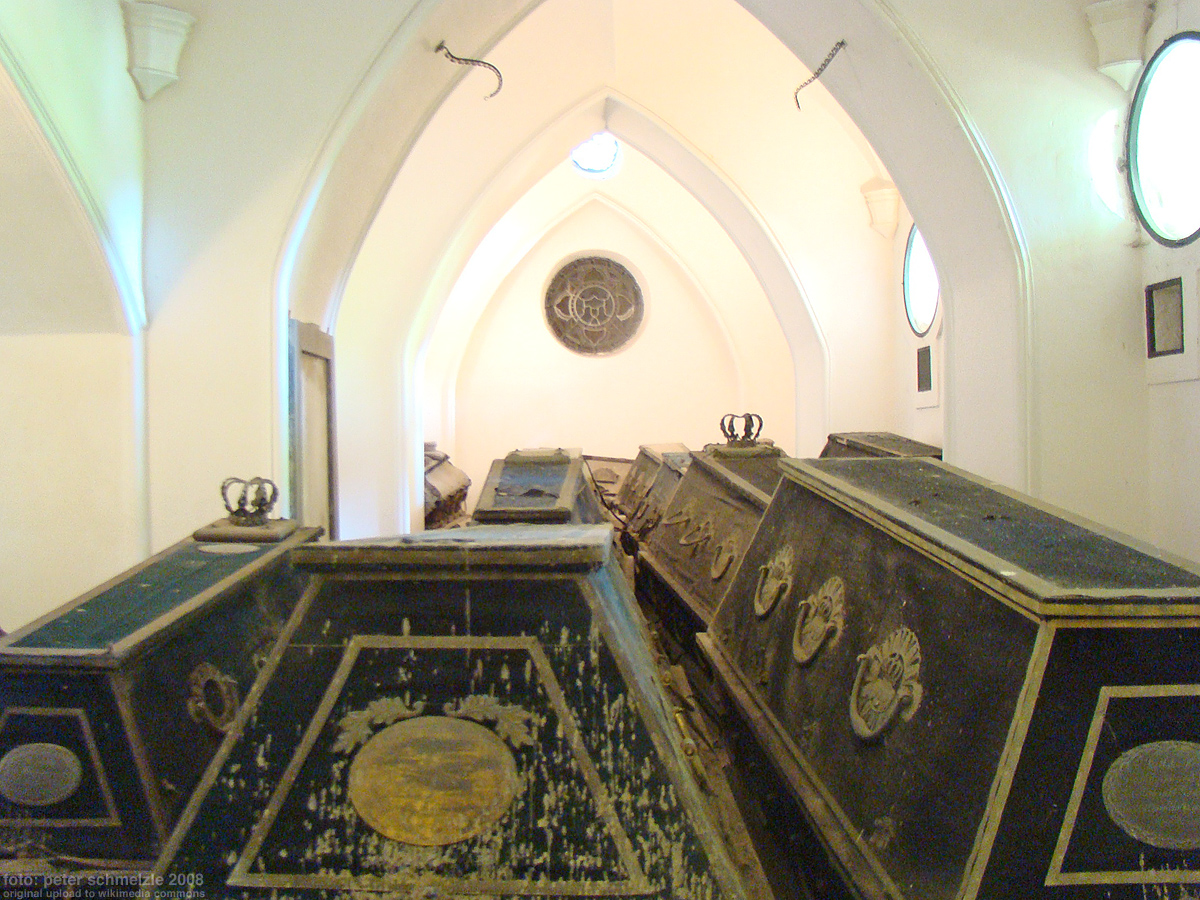by Susan Flantzer © Unofficial Royalty 2018

by Alexander Roslin, 1775; Credit – Wikipedia
Her destiny to be Empress of Russia was to remain unfulfilled. Princess Wilhelmine Luise of Hesse-Darmstadt began her life on June 25, 1755, in Prenzlau in the Kingdom of Prussia, now in Brandenburg, Germany, where her father was stationed with the Prussian army. She was the fifth of the eight children and fourth of the five daughters of Louis IX, Landgrave of Hesse-Darmstadt and Countess Karoline of the Palatinate-Zweibrücken.
Wilhelmine had seven siblings:
- Caroline of Hesse-Darmstadt (1746 – 1821), married Friedrich V, Landgrave of Hesse-Homburg, had eleven children including Friedrich VI, Landgrave of Hesse-Homburg who married Princess Elizabeth of the United Kingdom, daughter of King George III
- Friederike Luise of Hesse-Darmstadt (1751 – 1805), married King Friedrich Wilhelm II of Prussia, had seven children including King Friedrich Wilhelm III of Prussia and Wilhelmina of Prussia who married King Willem I of the Netherlands
- Ludwig X, Landgrave of Hesse-Darmstadt, later Ludwig I, Grand Duke of Hesse and by Rhine (1753 – 1830), married his first cousin Luise of Hesse-Darmstadt, had eight children
- Amalie of Hesse-Darmstadt (1754 – 1832), married Karl Ludwig, Hereditary Prince of Baden, had eight children including Caroline of Baden who married the first King of Bavaria, Maximilian I Joseph and Frederica of Baden who married and divorced King Gustav IV Adolf of Sweden
- Luise Auguste of Hesse-Darmstadt (1757 – 1830), married Karl August, Grand Duke of Saxe-Weimar-Eisenach, had seven children
- Friedrich of Hesse-Darmstadt (1759–1802), married morganatically Catharina Wenedick, had two children
- Christian of Hesse-Darmstadt (1763 – 1830), unmarried
Wilhelmine was brought up under the strict supervision of her mother Karoline, Landgravine of Hesse-Darmstadt, nicknamed “The Great Landgravine”. Karoline maintained friendly relationships with many scholars of the time including philosopher Johann Gottfried Herder, poet and writer Christoph Martin Wieland, and Johann Wolfgang von Goethe, perhaps the greatest German writer and poet. In addition, Karoline was in contact with Friedrich II (the Great), King of Prussia, and was one of the few women he respected. Karoline assembled a significant library as reading was one of her favorite pastimes. Brought up in this intellectually stimulating atmosphere, Wilhelmine was considered to have an outstanding intellect, a strong character, and a passionate temperament.

Catherine II (the Great) by Alexander Roslin, 1776; Credit – Wikipedia
In 1772, Catherine II (the Great), Empress of All Russia was searching for a bride for her 18-year-old son and heir Grand Duke Paul Petrovich (the future Paul I, Emperor of All Russia). Catherine the Great asked Friedrich II of Prussia for recommendations and his thoughts immediately turned to the three unmarried daughters of Karoline, Landgravine of Hesse-Darmstadt: Amalie, Wilhelmine, and Luise. Empress Catherine invited Landgravine Karoline and her three daughters to St. Petersburg. Four Russian ships were sent to take them to Russia. Andrei Razumovsky, Grand Duke Paul’s good friend, commanded the ship that transported Karoline and her three daughters. He was immediately charmed by the three sisters, particularly Wilhelmine who felt similar feelings towards Andrei.
Once the three sisters were in St. Petersburg, it did not take Paul long to make his choice. Just like his friend Andrei Razumovsky, Paul was charmed by Wilhelmine but she was not as enthusiastic about Paul. However, the wheels of diplomacy and protocol kept turning and preparations for the wedding began. Wilhelmine converted to Russian Orthodoxy on August 15, 1773, taking the name Natalia Alexeievna. The next day she was officially betrothed to Paul and was created a Grand Duchess of Russia.

Grand Duke Paul, the future Emperor Paul I by Alexander Roslin; Credit – Wikipedia
18-year-old Natalia and 19-year-old Paul were married on September 29, 1773, at the Church of the Nativity of the Blessed Virgin Mary in St. Petersburg which stood on the site where the Cathedral of Our Lady of Kazan now stands. The wedding was followed by ten days of celebration for the nobility and the common people. Paul was very happy with his new life and Natalia consoled herself with the knowledge that Andrei Razumovsky was always close at hand.

Andrei Razumovsky by Alexander Roslin; Credit – Wikipedia
Paul had been taken at birth by his great-aunt Elizabeth I, Empress of All Russia, and raised under her supervision. Even after the death of Empress Elizabeth, Paul’s relationship with Catherine hardly improved. Paul’s early isolation from his mother created a distance between them which later events would reinforce. At first, Natalia was very close to her mother-in-law Catherine II. Catherine had been in a similar situation – a German princess coming to Russia to marry the heir to the throne – so perhaps she had some sympathy for Natalia’s situation. Despite her misgivings about her marriage, Natalia did attempt to reconcile Catherine and her son who maintained a distant relationship and Catherine commented, “I am indebted to the Grand Duchess for returning my son to me.”
The happiness did not last long. After an initial settling-in, Natalia, after observing the Russian court, decided that she saw little good for herself there. She had been raised in an educated and liberal court and adhered to liberal ideas such as freeing the serfs and became involved in palace intrigues. This clearly did not please Empress Catherine. In addition, Natalia’s extravagance and her refusal to learn Russian annoyed Catherine. Catherine also heard rumors about Natalia’s relationship with Andrei Razumovsky. It does appear that the two had an affair and that Paul was ignorant of their relationship.

Natalia Alexeievna by Alexander Roslin, 1776; Credit – Wikipedia
All these issues were forgotten when, after two-plus years of marriage, Natalia became pregnant. Catherine did not care whether the child was Paul’s or Razumovsky’s. She just wanted an heir to the throne. On the morning of Sunday, April 10, 1776, Paul awakened his mother with the news that Natalia had been in labor since midnight. By noon, Natalia was in such pain that it seemed the birth would happen very soon. The afternoon and evening passed without a birth and Natalia was either in terrible pain or exhausted sleep. Monday passed and there was still no birth. On Tuesday, the doctors and midwives agreed that the child was probably dead. On Wednesday, the doctors all but gave up hope of saving Natalia and she was given the last rites. At six in the evening of Friday, April 15, 1776, 20-year-old Natalia died after six days of agony. Neither Catherine nor Paul had left her side. Catherine was furthered saddened that her dead grandchild had been a perfectly formed boy who had been too large to pass through the birth canal.
Despite her exhaustion and sadness, Catherine remained in control. She had to because Paul’s grief was so severe that he was refusing to allow Natalia’s body to be removed. Natalia was buried in the Annunciation Church at the Alexander Nevsky Monastery in St. Petersburg, Russia. Grief-stricken Paul did not attend the funeral but Catherine II did.

Tombstone of Grand Duchess Natalia Alexeievna; Photo Credit – Wikipedia
This article is the intellectual property of Unofficial Royalty and is NOT TO BE COPIED, EDITED, OR POSTED IN ANY FORM ON ANOTHER WEBSITE under any circumstances. It is permissible to use a link that directs to Unofficial Royalty.
Romanov Resources at Unofficial Royalty
Works Cited
- En.wikipedia.org. (2018). Natalia Alexeievna (Wilhelmina Louisa of Hesse-Darmstadt). [online] Available at: https://en.wikipedia.org/wiki/Natalia_Alexeievna_(Wilhelmina_Louisa_of_Hesse-Darmstadt) [Accessed 23 Jan. 2018].
- Lincoln, W. Bruce. (1981). The Romanovs: Autocrats of All the Russias. New York, NY.: Doubleday
- Massie, R. (2016). Catherine the Great. London: Head of Zeus.
- Ru.wikipedia.org. (2018). Наталья Алексеевна (великая княгиня). [online] Available at: https://ru.wikipedia.org/wiki/%D0%9D%D0%B0%D1%82%D0%B0%D0%BB%D1%8C%D1%8F_%D0%90%D0%BB%D0%B5%D0%BA%D1%81%D0%B5%D0%B5%D0%B2%D0%BD%D0%B0_(%D0%B2%D0%B5%D0%BB%D0%B8%D0%BA%D0%B0%D1%8F_%D0%BA%D0%BD%D1%8F%D0%B3%D0%B8%D0%BD%D1%8F) [Accessed 23 Jan. 2018].




 Marie Friederike of Hesse-Kassel, Duchess of Saxe-Meiningen
Marie Friederike of Hesse-Kassel, Duchess of Saxe-Meiningen














 Marie of Hesse-Kassel, Grand Duchess of Mecklenburg-Strelitz
Marie of Hesse-Kassel, Grand Duchess of Mecklenburg-Strelitz




 Friederike of Hesse-Darmstadt, first wife of Grand Duke Carl II
Friederike of Hesse-Darmstadt, first wife of Grand Duke Carl II

